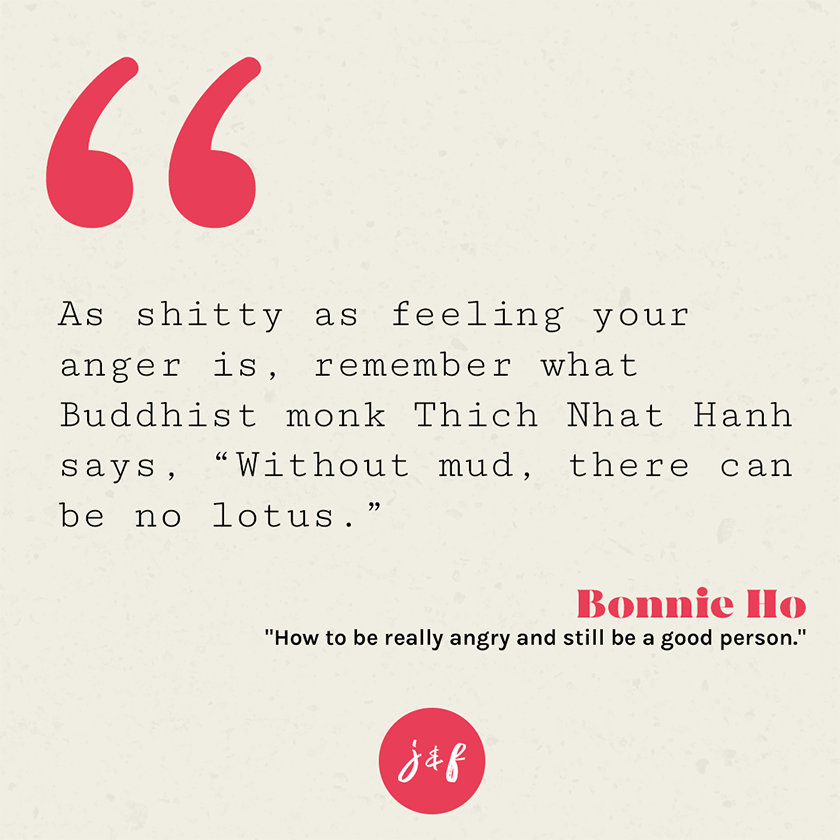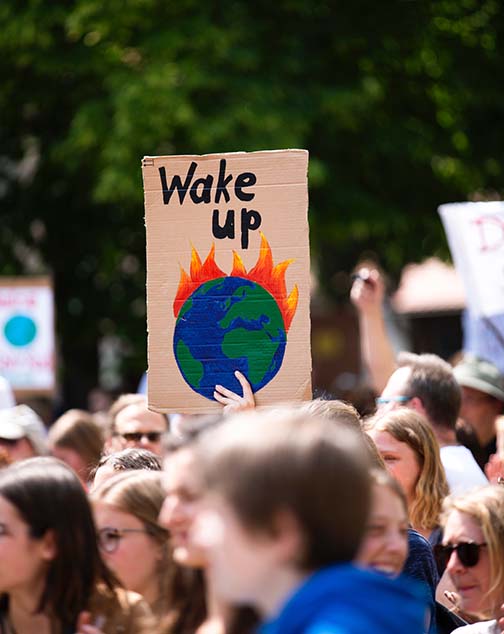
How to be really angry and still be a good person
I wasn’t born Catholic, but I might as well should have been. All my life, I’ve tried to be a good person. From a very early age, I wanted to be good — a good daughter, a good sister. I wanted to treat people with kindness. Have good manners. Live up to the saying, “Sharing is caring.” Be generous with everyone around me.
My effort to be good ended up over the top. But, it didn’t start that way. As a very young child, I cried a lot. My mother would be exhausted over my incessant crying and leave me to cry on my own. When I finished crying she would say, “Be good. Don’t cry anymore.” And then, she gave me a hug.
She didn’t mean to, but in that hug, my mother positively reinforced a pretty dangerous belief: If I don’t cry or show emotion, then I am good.
With that knowledge, I would see kids throwing tantrums and I’d scoff at them for their lack of control. They weren’t good. I secretly prided myself on my ability to control my emotions. Little did I know, I was suppressing one of the most powerful tools my body has: my emotions.
Anger has a purpose — to create change
Years ago in my past life as a lead consumer researcher, I walked into a meeting to present research findings that my fellow researcher and I had spent a lot of time on. At that point, I’d been at the company a couple of years, but my experience had been rocky from the beginning. My colleagues didn’t understand how proper research is conducted, what it’s for, why it’s important. Luckily, my manager understood what I was trying to do and always had my back.
In the middle of our presentation, one of the stakeholders interrupted us, “Can I just stop here and say, I don’t know what this is? I don’t know how to use this. I just wish it was what we asked for.”
Something in me lost it. I got angry.
I’d heard feedback like his comment early on, so I’d gone above and beyond to address those concerns. I’d shared out PowerPoint presentations clearly articulating why we were doing the research we were doing. I’d invited experts to come speak to the team, so they could get an outside perspective. And yet here we were. Nothing was going to be good enough.
I’d gone above and beyond to address those concerns…. And yet here we were. Nothing was going to be good enough.
As I became angrier, the unthinkable happened. I started to cry. I ran out of the room and into the restroom. Eventually, I snuck out of the building and found an alley where I could get a hold of myself.
My manager texted me: “Bonnie, are you okay. I’m sorry about what happened.”
I texted back: “I can’t do it anymore.”
My manager texted: “I understand. Take the time you need.” And, later: “I’d like to talk when you’re ready.”
After a while, I knew I had to go back and face everyone. My manager brought me into a room and told me what had happened after I left. He had gotten very angry (which is very unlike him) and shut down the meeting. He stood up and announced, “No one is getting any research until you understand research! NO ONE!” He asked me not to quit and promised to better support me.
Later that day, one of the stakeholders asked to speak to me. He admitted, “It’s not everyday that you learn something. And today, I learned something.” He owned his own stubbornness. Instead of being open to what I had to say, he had been stuck in his competitive ways.
After that day, my working relationships started to change. Even the person who interrupted me started to listen.
Is your anger empowering or hurtful?
As good people, one of our biggest fears is that we might hurt someone. When we feel anger becoming explosive or uncontrollable, like it was for me in that conference room, we want to shut it down. However, when we shut out our anger, we also shut out the gifts that anger can give us. I’ve outlined below how you can be practical with your anger by hearing its message and allowing it to empower you.
Step 1: Give yourself permission to feel anger
We, good persons, often block out anger so we don’t have to feel it. When we get into the habit of not feeling anger, it can be quite an adjustment to start feeling it. It’s uncomfortable and painful, which is why we cry sometimes when we get angry. Under all of the anger is grief from not allowing ourselves an emotion we need. If we are brave enough to run into the fire, there is a freedom and peace when we start to let it go.
Feeling your anger is a practice of awareness and allowance. I have found that when I am angry, if I can sit for a moment and tell myself “I give myself permission to be angry,” the anger subsides, just a bit.
Anger is funny like that. When we don’t give it permission, it swells up like a defiant teenager.
As shitty as feeling your anger is, remember what Buddhist monk Thich Nhat Hanh says, “Without mud, there can be no lotus.”


Step 2: Journal your anger, or have a tantrum
When we start to feel angry, we need to honor and acknowledge it. Otherwise, it will stew inside us, causing dismay, confusion, anxiety, or even more anger.
Journaling is a great way to give yourself — and your anger — space to say what you need to say. Sometimes we manicure our anger, and downplay what we’re really feeling inside. Journaling is the time when you can let it all out. Be a drama queen, swear like a sailor, whine like a baby. That’s the beauty of journaling. No one else will see it, so go wild.
Feeling physical with your anger? Go into a private space and do what your parents never let you: throw an adult-sized temper tantrum. Kick and scream. Punch a pillow. Or, if that doesn’t feel good to you, go for a run, dance, or do a kickboxing class.
Feeling physical with your anger? Go into a private space and do what your parents never let you: throw an adult-sized temper tantrum.
Step 3: Ask your anger, “Are you new or old?”
If you’re a self-help junkie like me, then you already know that anger can be triggered by old wounds. We’ve all had the experience where something that should be a minor offense balloons into full-on rage as a past wound is triggered. When we feel outsized anger to minor offenses, there’s a good chance a past wound is getting triggered. In these instances, be gentle with yourself. There’s a pain behind all that anger.
But, of course, not all anger is simply an old trigger. Sometimes, anger wants us to take action in the now. When the stakeholder interrupted me in my meeting, I was being disrespected. My anger wanted me to express that it was not okay for me to be treated this way. It wanted to protect me. When you start feeling angry, ask yourself: What is the most self-loving action I can take right now?
It might be speaking up for yourself. Or putting up a boundary. Or getting yourself out of a situation. Be courageous and be honest with yourself. Anger is fiery because it wants you to take back your power.
Step 4: Thank your anger
As good people, our relationship with anger can be troubled. But, as we’ve seen, anger is what motivates you to act when you’ve been trespassed, disrespected, or violated. We can appreciate and befriend our anger for what it brings us: our empowerment. You might write your anger a thank you note, something like:
Dear Anger,
Thank you! Thank you for letting me know about _____________________ [ex: how I was unloving towards myself in this situation]. I have decided to ___________________ [ex: give feedback to this stakeholder]. This has been a great lesson for me, and I will remember to ___________ [ex: be more aware when I’m being disrespected], and to do what is most loving for myself.
I appreciate you, Anger!
Love, [Name]

How to be (productively) angry at the world
We’re all angry, aren’t we? Whether it’s politics or social justice, something in your world likely feels like it’s on fire.
As we laid out above, we can see how we might take anger’s cue to protect ourselves when we’ve been personally wronged. But, what do you do when you witness a world being wronged? How can anger serve us then?
We can see how we might take anger’s cue to protect ourselves when we’ve been personally wronged. But, what do you do when you witness a world being wronged?
We can harness that anger to take bold action in order to move humanity forward. We can allow anger to motivate us to stand up for what we believe in, to do what we feel is right. Ask yourself: what is the most appropriate action for me to take, in order to help this outer-world situation? Is it to protest in the street? Is it to vote? Is it to encourage other people to vote? Is it to donate money to charities? Is it to talk about the issues with those who don’t understand? Everyone has an action that is right for them according to their values, role, and skill sets.
Next, take a moment to assess your own inner state. Sometimes we feel rage against the world when our own inner unresolved feelings are triggered. To give a personal example:
I am triggered by President Trump’s incompetence because I fear that I am incompetent. This comes from a childhood where my parents didn’t believe in me. I failed first grade, which was a huge embarrassment to me and my family. This fear of embarrassment is resurfacing as I am transitioning careers. What if I am incompetent in my new career?
As I begin to recognize where I need care and tenderness inside me, I can begin to let go of my grip on solving the world’s problems. World events will still bother me, but seeing how the events are just showing me where I need healing helps me detach from the intensity and view everything with a bit more neutrality.
Sorry, the comment form is closed at this time.




Pingback: The wisdom of anger – BONNIE HO INSIGHTS